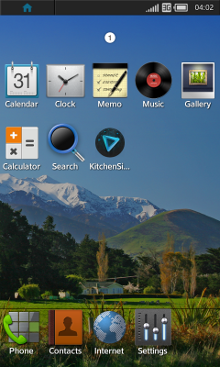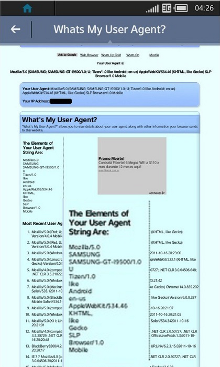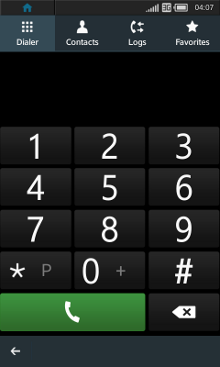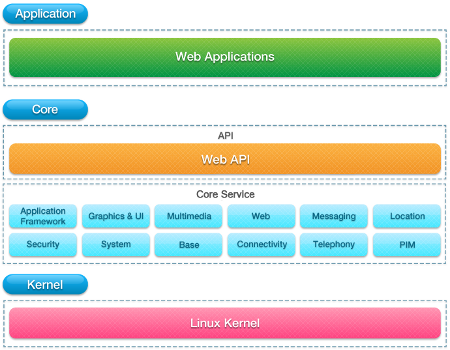Tizen OS alpha released, may debut on Samsung I9500 smartphone
Jan 12, 2012 — by Eric Brown — from the LinuxDevices Archive — 1 viewsThe Linux Foundation's Tizen project has previewed an alpha version of its MeeGo and LiMo-based mobile operating system and SDK. The HTML5-oriented release — including components from the carrier-backed WAC interoperability standards and the Enlightenment Foundation Libraries — follows rumors of Intel-based Tizen tablets, plus a screenshot leak that suggests an appearance on an upcoming Samsung I9500 phone.
Somewhat lost in the deluge of Android-related announcements at this week's Consumer Electronics Show, another open source Linux operating system (OS) quietly staked its claim. Hosted by the Linux Foundation — and backed by Intel and Samsung as a potential future alternative to Android — the Tizen project released an alpha version of the Tizen OS.
The release is described as a "very early preview" of pre-release source code, tools, and documentation designed to give application developers an early look at Tizen.


Leaked screenshots of Tizen home page (left), as well as a user agent screen that suggests an upcoming Samsung I9500 smartphone
Source: SamMobile
(Click on either to enlarge)
Announced back in September, Tizen is a combination of the MeeGo and LiMo mobile Linux operating systems (OSes), re-engineered on a cloud-oriented HTML5 platform. A "formal release" of the code, presumably in beta form, is due in the "coming months," according to the Tizen Technical Steering Group. In September, the project said that the first Tizen products would come to market in mid-2012.
The preview release includes Tizen OS source code, encompassing middleware, the basic user interface, and the menu interface, says the project. Also included are the Tizen software developer kit (SDK) and APIs, which together include a web IDE (integrated development environment), emulator, web API documentation, and toolchain.
The initial platform is designed for smartphones and tablet devices, although additional segments will be "defined soon," says the project. In September, the project announced plans to support categories that largely mirror MeeGo's UXes (User eXperiences), including smartphones, tablets, smart TVs, netbooks, and in-vehicle infotainment systems.


Tizen dialer (left) and task switcher
Source: SamMobile
(Click on either to enlarge)
As noted by SlashGear, the UI seems more reminiscent of Android or Samsung's Bada OS than LiMo or MeeGo. Bada is a mobile middleware platform that can run atop either a Linux kernel or a real-time operating system (RTOS), such as the Nucleus OS at the heart of its Samsung Wave smartphone.
Samsung's Bada has apparently done quite well for itself, although phones based on it are not available in the U.S.. It's unclear whether Samsung plans to replace Bada with Tizen, offer them as separate low-end and high-end platforms, or eventually merge the two.
Intel hints at Tizen tablets
Samsung's Tizen partner Intel, meanwhile, is involved in plans for Tizen tablets, according to a Jan. 12 report from PCMag. The chipmaker recently launched an all-out effort in to get its new, low-power Atom Z2460 ("Medfield") processor onto phones and tablets running Android. However, it is talking to wireless carriers about potential Tizen tablets, according to the story.
The story quotes Mark Miller, director of marketing for Intel's netbook and tablet segments, as saying Tizen is attractive to mobile providers "because it enables them to differentiate" more than they can with Android, and "they can add a lot more to the UI." He was said to have added that Tizen's HTML5 focus should mean a fast ramp-up of available apps.
According to PCMag. Miller hinted at more Tizen announcements at the Mobile World Congress show. "That transition to Tizen may happen next quarter; a lot of it has to be worked through, and development plans are still being worked on," Miller was quoted as saying.
Inside Tizen
The Tizen architecture starts with a Linux kernel foundation, and adds a variety of core services, including connectivity, which is based in part on MeeGo's ConnMan connection manager, according to the project. Tizen also offers a wide range of wireless services, including near field communication (NFC). Other core services include security, multimedia, telephony, location, PIM, messaging, web (Webkit), and the graphics/UI.

Tizen architecture
In addition to EFL, the graphics/UI layer includes an X11-based window management system, input methods, and OpenGL ES, says the project.
Core services also include an Application Framework that provides application launching and management, as well as pre-defined launching of services such as the system dialer. In addition, the Framework is said to provide event notifications such as low memory, low battery, screen orientation changes, and push status.
Atop this core level of services resides the web API designed for developing apps. This layer includes HTML5 and other W3C standards, as well as Khronos WebGL and "newly defined device APIs," says the project.
As was originally announced, Tizen borrows a number of components from the LiMo Foundation's floundering LiMo spec, which is still used by a number of feature phones in Japan, but has made it to only a few smartphones released elsewhere. The key component is a common app format borrowed from the Wholesale Applications Community (WAC) mobile carrier industry group. The LiMo spec is said to be compliant with WAC standards, which in turn incorporate the Open Mobile Terminal Project's BONDI and the Joint Innovation Lab's JIL initiative.
Tizen tools, meanwhile, include a Web SDK based on HTML5, JavaScript and CSS. The SDK is said to support JavaScript with native extensions, including support for email, SMS, PIM, and device information integration.
Developers are encouraged to download and review the Tizen OS and SDK, and provide feedback via an IRC channel and/or mailing lists. The latter are said to include general, application developer, and product developer focused lists.
Availability
The Tizen alpha release is available now for free download. More information may be found at the Tizen website.
This article was originally published on LinuxDevices.com and has been donated to the open source community by QuinStreet Inc. Please visit LinuxToday.com for up-to-date news and articles about Linux and open source.